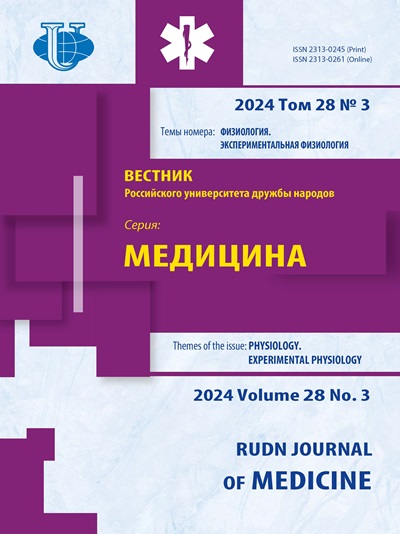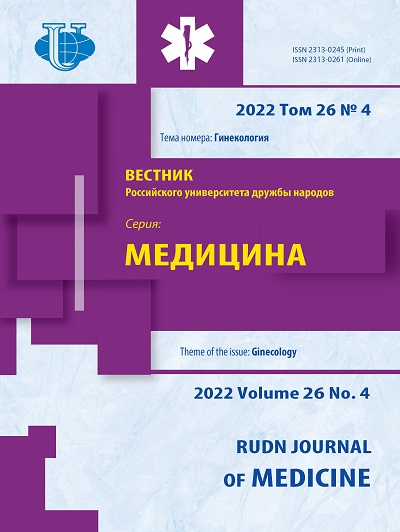Новые аспекты в хирургической коррекции тазового пролапса
- Авторы: Варданян В.Г.1, Алёхин А.И.1, Межлумова Н.А.1, Певгова Г.Ю.1, Алёхин А.А.1
-
Учреждения:
- Научно-клинический Центр № 2 Центральной клинической больницы Российского научного центра хирургии имени академика Б.В. Петровского
- Выпуск: Том 26, № 4 (2022): ГИНЕКОЛОГИЯ
- Страницы: 373-381
- Раздел: ГИНЕКОЛОГИЯ
- URL: https://journals.rudn.ru/medicine/article/view/32991
- DOI: https://doi.org/10.22363/2313-0245-2022-26-4-373-381
Цитировать
Полный текст
Аннотация
Актуальность проблемы тазового пролапса обусловлена распространенностью заболевания, тенденцией к омоложению и прогрессированию. Это, согласно анкетированию, влияет на качество жизни женщин, приводит к нарушению сексуального функционирования, снижает трудоспособность. Существующие в арсенале современной оперативной гинекологии способы хирургического лечения могут способствовать развитию рубцово-спаечного процесса, инфекционных осложнений и рецидива пролапса, что создает необходимость проведения повторных вмешательств. Разработка и внедрение в практику новых способов лечения являются закономерной необходимостью. Наиболее эффективной техникой хирургического лечения пролапса гениталий является лапароскопическая сакрокольпопексия с использованием имплантов из титанового шелка. Материалы и методы . Проведено проспективное когортное исследование 30 пациенток в возрасте от 37 до 74 лет с клиническими проявлениями пролапса II-IV степени, статистический анализ данных и анализ результатов анкетирования пациенток в послеоперационном периоде в динамике через 3-6-12 месяцев в период с 2019 по 2021 год. В исследовании была использована трехэтапная методика оперативного пособия (патент от 15.09.2020 года № 2020130382/14(054923) в объеме - лапароскопическая промонтофиксация, пластика крестцово-маточных связок по MacCoul, кольпоррафия, кольпоперинеоррафия, леваторопластика. Результаты и обсуждение . Установлено, что беременность и роды относят к основным факторам, провоцирующим развитие несостоятельности мышц тазового дна. Длительность послеоперационного наблюдения в нашем исследовании составила 3-14 месяцев. За этот период осложнений диагностировано не было. У 12 пациенток (40,0 %) в течение первого месяца отмечались периодические тянущие боли в нижних отделах живота и промежности, у 2 (6,6 %) - недержание мочи. Титановый шелк обладает меньшим сродством с окружающими тканями по сравнению с полипропиленовыми каркасными системами, что позволяет рассматривать его в качестве альтернативного материала синтетическим аналогам и снизить риск mesh-ассоциированных осложнений. Устойчивость титанового эндопротеза к антисептикам и микробным агентам предрасполагает к его долгосрочному использованию и отсутствию необходимости замены. Выводы . Полученные данные позволяют судить о высокой эффективности разработанной методики хирургического лечения тазового пролапса дефектов тазового дна у больных с ректоцеле и цистоцеле, минимизации рецидивов заболевания и риска развития mesh-ассоциированных осложнений, что позволяет выбрать персонализированную тактику ведения данной когорты пациенток.
Ключевые слова
Об авторах
В. Г. Варданян
Научно-клинический Центр № 2 Центральной клинической больницы Российского научного центра хирургии имени академика Б.В. Петровского
Email: science@ckbran.ru
ORCID iD: 0000-0003-4907-6527
г. Москва, Российская Федерация
А. И. Алёхин
Научно-клинический Центр № 2 Центральной клинической больницы Российского научного центра хирургии имени академика Б.В. Петровского
Автор, ответственный за переписку.
Email: science@ckbran.ru
ORCID iD: 0000-0002-3689-921X
г. Москва, Российская Федерация
Н. А. Межлумова
Научно-клинический Центр № 2 Центральной клинической больницы Российского научного центра хирургии имени академика Б.В. Петровского
Email: science@ckbran.ru
ORCID iD: 0000-0002-6113-944X
г. Москва, Российская Федерация
Г. Ю. Певгова
Научно-клинический Центр № 2 Центральной клинической больницы Российского научного центра хирургии имени академика Б.В. Петровского
Email: science@ckbran.ru
ORCID iD: 0000-0003-0414-4485
г. Москва, Российская Федерация
А. А. Алёхин
Научно-клинический Центр № 2 Центральной клинической больницы Российского научного центра хирургии имени академика Б.В. Петровского
Email: science@ckbran.ru
ORCID iD: 0000-0001-5894-5574
г. Москва, Российская Федерация
Список литературы
- Chen B., Yeh J. Alterations in connective tissue metabolism in stress incontinence and prolapse // J Urol. 2011. V. 186. № 5. P. 1768-72. doi: 10.1016/j.juro.2011.06.054
- Campeau L., Gorbachinsky I., Badlani G.H., Andersson K.E. Pelvic floor disorders: linking genetic risk factors to biochemical changes // BJU Int. 2011. V. 108. № 8. P. 1240-7. doi: 10.1111/j.1464410X.2011.10385.x
- Краснопольский В.И., Попов А.А., Абрамян К.Н., Пушкарь Д.Ю, Гвоздев М.Ю, Серегин А.С., Петрова В.Д, Добровольская Т.Б, Насырова Н.И. Осложнения экстраперитонеальной кольпопексии с применением сетчатых протезов: результаты многоцентрового исследования // Российский вестник акушера-гинеколога. 2010. Т. 10. № 6. С. 53-57
- Севастьянов В.И., Кирпичников М.П. Биосовместимые материалы: Учебное пособие. Москва: Изд-во МИА, 2011. 544 с.
- Le Normand L., Cosson M., Cour F., Deffieux X., Donon L., Ferry P., Fatton B., Hermieu J.F., Marret H., Meurette G., Cortesse A., Wagner L., Fritel X. Clinical practice guidelines: Synthesis of the guidelines for the surgical treatment of primary pelvic organ prolapse in women by the AFU, CNGOF, SIFUD-PP, SNFCP, and SCGP // 2016;45(10):1606-1613. doi: 10.1016/j.jgyn.2016.09.020
- Крутова В.А., Тарабанова О.В., Хачецукова А.А. Стрессовое недержание мочи de novo у женщин после коррекции пролапса гениталий // Вопросы гинекологии, акушерства и перинатологии. 2018. Т. 17. № 6. С. 26-32. doi: 10.20953/1726-1678-2018-6-26-32
- Ищенко А.И., Александров Л.С., Ищенко А.А., Горбенко О.Ю., Тарасенко Ю.Н., Худолей Е.П. К вопросу о патогенезе тазовой дисфункции. Вопросы гинекологии, акушерства и перинатологии // 2016. Т. 15. № 5. С. 53-8. doi: 10.20953/1726-16782016-5-53-58
- Паршиков В.В., Миронов А.А., Аникина Е.А., Заславская М.И., Алехин А.И., Казанцев А.А. Протезирующая пластика брюшной стенки с применением легких и ультралегких синтетических и титансодержащих материалов в условиях высокой бактериальной контаминации (экспериментальное исследование) // Современные технологии в медицине. 2015. № 4. С. 64-71. doi: 10.17691/stm2015.7.4.08
- Чечнева М.А., Буянова С.Н., Попов А.А., Крaснопольский В.И. Ультразвуковая диагностика пролапса гениталий и недержания мочи у женщин. Москва: МЕДпрессИнформ. 2016. 136 с.
- Паршиков В.В., Миронов А.А., Аникина Е.А., Казанцев А.А., Заславская М.И., Алехин А.И. К вопросу о возможности применения ультралегких титансодержащих сетчатых эндопротезов для пластики брюшной стенки в условиях инфицирования (экспериментальное исследование) // Хирургия. Журнал им. Н.И. Пирогова. 2016. № 11. С. 64-70. doi: 10.17116/hirurgia20161164-70
- Колпаков А.А., Казанцев А.А. Сравнительный анализ результатов применения протезов «титановый шелкˮ и полипропилена у больных с послеоперационными вентральными грыжами // Русский медицинский журнал. 2015. Т. 23. № 13. С. 774-775.
- Kawaguchi S., Narimoto K., Hamuro A., Nakagawa T., Urata S., Kadomoto S., Iwamoto H., Yaegashi H., Iijima M., Nohara T., Shigehara K., Izumi K., Tachibana D., Kadono Y., Mizokami A., Koyama M. Transvaginal polytetrafluoroethylene mesh surgery for pelvic organ prolapse: 1-year clinical outcomes // Int J Urol. 2021. V. 28. № 3. P. 268-272. doi: 10.1111/iju.14444
- Kato K., Gotoh M., Takahashi S., Kusanishi H., Takeyama M., Koyama M. Techniques of transvaginal mesh prolapse surgery in Japan, and the comparison of complication rates by surgeons’ specialty and experience // Int. J. Urol. 2020. № 27. P. 996-1000. doi: 10.1111/iju.14343
















